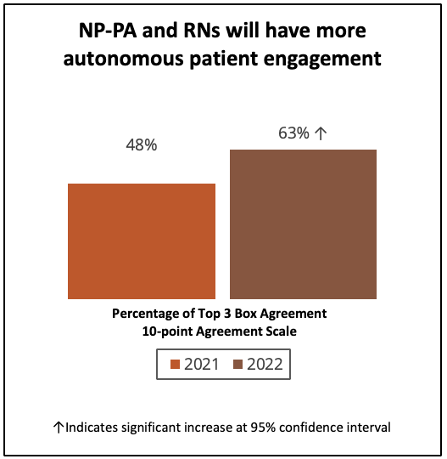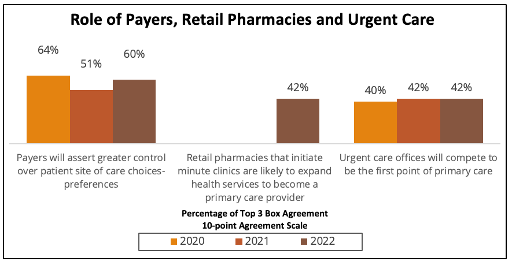Who are making the decisions in health care? Research looks at changes to health care provider roles and autonomy
Editor’s note: Alissa Algarin is research director at Olson Research Group.
For the past three years, Intellus Worldwide has conducted a “Trends and Futures” survey to track the ever-changing pharmaceutical marketplace and uncover industry trends.1 Wave 3 (Q1 2022) was conducted among a sample of health care market researchers at biopharmaceutical and health care companies (industry), as well as market research, data, technology and sample providers (agency).
Who is providing the primary care?
Even before COVID, there were concerns about a decreasing number of physicians and a looming shortage. Today, with the resulting stress, burnout and health care providers leaving the field it is an increasingly worse problem.
“The U.S. faces a projected shortage of between 37,800 and 124,000 physicians within 12 years, according to The Complexities of Physician Supply and Demand: Projections From 2019 to 2034 (PDF), a report released by the Association of American Medical Colleges (AAMC).”
Doctor shortages are here – and they’ll get worse if we don’t act fast | American Medical Association (ama-assn.org).
The impact of this problem is top-of-mind among health care marketing researchers as well. Among the top overall trends2 tracked by Intellus over the past three years, agreement increased significantly for only one:
“NP/PA and RNs will have more autonomous patient engagement”
Agreement with this trend around nurse practitioners (NP), physician assistants (PA) and registered nurses (RN) was the highest among overall trends for 2022 (63% top 3 box) and increased significantly from 2021 (48%).

This trend was also called out on an unaided basis. A director at a large pharmaceutical company cited the “Continued rise of non-HCP Dx and Rx (NP, PA, PharmD)” as a top trend for the coming three years.
NPs/PAs will increasingly be the primary health care provider for patients. Physicians interviewed as part of this research agree there is a need for more NP/PA autonomy to fill capacity shortfalls, and many rely heavily on their own. Many NPs/PAs take on their own patients and can prescribe without oversight in some states.
Patients are open to the idea of receiving care from NPs/PAs when visiting a practice. “I think they (NPs/PAs) are as good or are even doing more of the work. They are more hands on,” said a patient in qualitative research conducted as part of the 2022 study.
How changes to health care provider roles impacts health care marketing research
So, what are the implications for health care marketing research? Researchers will need to reach out to NPs/PAs and RNs directly since they will have an increasing role in care, treatment and prescribing. Panel and sample providers should begin now to increase recruitment of this key audience. Given the time limitations facing NPs/PAs and RNs, increasing fair market value
rates for this audience and accommodating their schedules will be important to achieve the desired participation.
Are the roles of payers, retail pharmacies and urgent cares changing?
While some health care providers will have a growing role in patient care, practitioners increasingly find themselves answering to payers, health care systems and governments.
The second-highest agreement for a top trend in the coming three years is that “Payers will assert greater control over patient site of care choices – preferences.” However, patients ultimately drive their site of care choices and payers may need to follow suit to stay competitive.

Two-fifths of respondents also see urgent care offices and retail pharmacies emerging as competitors for primary care. A statement about retail pharmacies expanding into health care was added for the first time in Wave 3 of the study and generated 42% top box agreement among respondents.
Primary care providers interviewed as part of this research also often agree that they have lost autonomy in practicing medicine over the years.
- MDs increasingly feel beholden to insurance companies that demand more and more paperwork, often linked to outcome reporting, and dictate steps that must be taken for medication approval.
- Many primary care providers have willingly joined larger groups or systems that require standardization, sacrificing autonomy for administrative support and stability.
“I don’t think we have any autonomy ... The quality has gone down because of too much paperwork and documentation. You feel more burnt out. What’s driving this is insurance companies placing too many measures.” – Primary care provider
The emphasis on lowering prescription drug prices as part of The Inflation Reduction Act of 2022, signed into law by President Joe Biden in August, will mean even more oversight from insurance companies and health care systems as they seek to reduce costs. The results are likely to translate into a greater probability of prescribing constraints.
Research must incorporate health care personnel and payer workstreams
For health care marketing researchers this means that in addition to understanding health care providers preferences and choices, there is a need to integrate learnings from both health care personnel and payer workstreams.
Payers, insurance companies and health care system managers need to be included when conducting marketing research. Like NPs/PAs and RNs, these represent new key audiences for researchers. Gaining access to these decision makers will be key for successful research in the coming years.
1. Methodology:
The Intellus Trends and Futures Committee partnered with Trinity Life Sciences (Trinity Life Sciences) to track the ever-changing pharmaceutical marketplace and the impact those changes may have for the market research professional through the annual “Trends and Futures” survey. The “Trends and Futures” survey seeks to gain a deeper insight across several categories from the perspective of manufacturers and agency suppliers. The Wave 1 (Q1 2020) survey focused on identifying broader trends influencing health care researchers. Wave 2 (Q1 2021) sought broader insights across the key thematic areas of: consumers, clinical trials and technology. Wave 3 (Q1 2022) looked at broader overall trends, trends specific to industry practitioners (health care market researchers at biopharmaceutical and health care companies), and trends specific to agency marketing research vendors and partners.
The quantitative research is based on 312 respondents across the three waves. Statistical differences have been shown at the 95% confidence level.
The Intellus Trends and Futures Committee partnered with InCrowd and Rare Patient Voice (Providing patients and caregivers a voice - Rare Patient Voice) to conduct qualitative research with health care providers and patients.
Wave 4 of the annual Intellus Worldwide Trends & Future Survey will field in March launched at the Summit in Philadelphia. For more information, visit intellus.org.
2. Among overall trends (among both industry and agency respondents) with at least 30% top 3 box agreement on a 10-point agreement scale.
Intellus Worldwide thanks the Trends and Future Committee for their leadership and tireless dedication to this effort: Jarod Ricci, GSK; Steve Yonish, Trinity; Abbey Ahearn, Hawk Partners; Dom Cocco, MedSurvey; Peter Simpson, Sarasota Ventures; Alissa Algarin, Olson Research Group; Bhavani Moodabagil, Biogen;Emily Hoffman, Research Partnership; Sherry Fox, Future Health Strategies; Karen Higginbottom, AplusA Research
